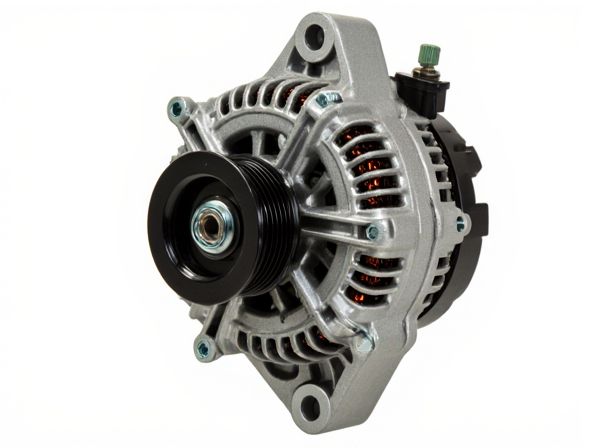
Photo illustration: High-Output vs Standard Output Alternator
High-output alternators provide greater electrical power, ensuring your vehicle's accessories and systems run efficiently even under heavy demand. Standard output alternators deliver sufficient power for basic electrical needs, making them suitable for everyday driving without extensive electronic modifications. Choosing the right alternator depends on your vehicle's power requirements and any additional equipment you plan to use.
Table of Comparison
| Feature | High-Output Alternator | Standard Output Alternator |
|---|---|---|
| Power Output | 120-300 Amps | 70-120 Amps |
| Ideal Use | Vehicles with multiple electronics, aftermarket audio, heavy electrical demands | Standard vehicles, factory electrical systems |
| Charging Efficiency | Higher efficiency at low RPMs | Basic efficiency, optimal at moderate RPMs |
| Price Range | $150 - $400 | $50 - $150 |
| Lifespan | 7-10 years | 5-7 years |
| Weight | Slightly heavier due to enhanced components | Lighter, standard build |
| Compatibility | Supports high electrical demand vehicles | Designed for stock vehicle electrical systems |
Introduction to Alternators
Alternators are essential components in vehicle electrical systems, responsible for converting mechanical energy into electrical energy to power the battery and electrical accessories. High-output alternators produce significantly more amperage compared to standard output alternators, supporting additional electrical demands from aftermarket accessories and advanced vehicle systems. Understanding the differences in amperage output and efficiency helps determine the appropriate alternator type for specific power requirements.
What is a High-Output Alternator?
A high-output alternator is designed to deliver significantly more electrical current than a standard output alternator, typically producing 150 to 300 amps compared to the standard 70 to 120 amps. This increased capacity supports vehicles with multiple electrical accessories, such as high-powered audio systems, auxiliary lighting, and additional electronic devices. High-output alternators feature enhanced internal components and cooling systems to maintain performance and reliability under heavy electrical loads.
Understanding Standard Output Alternators
Standard output alternators typically generate between 50 and 140 amps, sufficient for most passenger vehicles to power electrical systems and recharge the battery during engine operation. These alternators balance efficiency and durability, making them cost-effective for everyday use without the need for excessive electrical capacity. Understanding the voltage regulation and cooling mechanisms in standard alternators is essential to ensure optimal performance and longevity under regular driving conditions.
Key Differences Between High-Output and Standard Output Alternators
High-output alternators typically deliver 140 to 400 amps, compared to standard output alternators that produce around 70 to 130 amps, providing significantly increased electrical capacity for vehicles with multiple accessories or advanced electronics. The key differences include enhanced cooling systems, heavier-duty internal components, and often larger physical size to manage the increased load and prevent overheating. High-output alternators are essential for vehicles with high electrical demands such as off-road trucks, emergency vehicles, and performance cars, whereas standard alternators suffice for regular everyday driving needs.
Applications Suited for High-Output Alternators
High-output alternators are essential for vehicles equipped with numerous electrical accessories, such as off-road trucks, emergency response vehicles, and luxury cars with advanced infotainment systems. These alternators provide significantly higher amperage, typically ranging from 160 to over 300 amps, compared to standard alternators that produce between 60 and 120 amps. High-output alternators ensure reliable power delivery for demanding applications like winches, auxiliary lighting, high-performance audio systems, and multiple battery setups.
When to Choose a Standard Output Alternator
Choose a standard output alternator when your vehicle's electrical demands are moderate, such as in everyday driving conditions without extensive aftermarket accessories. Standard alternators typically produce between 60 to 120 amps, sufficient for powering factory-installed equipment like headlights, stereo systems, and air conditioning. Opting for a standard output alternator ensures cost-effectiveness and reliable performance without the added complexity and expense of high-output models.
Performance and Efficiency Comparison
High-output alternators generate significantly more electrical power, typically ranging from 200 to 400 amps, compared to standard output alternators producing 60 to 120 amps, enhancing vehicle performance by supporting additional electrical components and preventing battery drain. These alternators improve efficiency by reducing engine load during high-demand conditions, thereby optimizing fuel consumption and prolonging battery life. High-output models are essential in vehicles with extensive electrical systems, such as off-road trucks and emergency vehicles, where consistent and reliable power flow is critical.
Impact on Vehicle Electrical Systems
High-output alternators deliver increased amperage, supporting advanced vehicle electrical systems like high-powered audio, additional lighting, and multiple electronic devices without straining the battery or voltage regulator. Standard output alternators provide sufficient power for basic electrical loads but may fail to maintain voltage stability under substantial accessory demands, risking premature battery depletion. Upgrading to a high-output alternator enhances overall electrical system reliability and performance, especially in vehicles equipped with power-hungry components.
Installation Considerations and Compatibility
High-output alternators require careful assessment of vehicle electrical system capacity and compatibility with existing wiring, battery, and voltage regulators to prevent overload and ensure optimal performance. Installation demands appropriate mounting brackets, upgraded wiring harnesses, and consideration of alternator physical size to fit the engine bay without interference. Standard output alternators typically offer straightforward replacement with OEM parts, minimizing compatibility issues and installation complexity in most vehicles.
Conclusion: Selecting the Right Alternator for Your Needs
Choosing between a high-output and a standard output alternator depends on your vehicle's electrical demands and accessory usage. High-output alternators provide increased power capacity ideal for vehicles with multiple electronic devices or aftermarket upgrades, while standard alternators are suitable for everyday driving with factory-installed equipment. Evaluating your power requirements ensures optimal performance and prevents electrical system strain.
 caratoz.com
caratoz.com